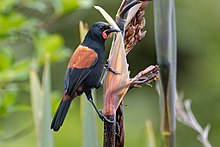North Island saddleback
| North Island saddleback | |
|---|---|

| |
| North Island saddleback on Tiritiri Matangi Island | |
| Scientific classification | |
| Domain: | Eukaryota |
| Kingdom: | Animalia |
| Phylum: | Chordata |
| Class: | Aves |
| Order: | Passeriformes |
| Family: | Callaeidae |
| Genus: | Philesturnus |
| Species: | P. rufusater
|
| Binomial name | |
| Philesturnus rufusater (Lesson, 1828)
| |

| |
Islands and sanctuaries where North Island saddlebacks are present
| |
| Synonyms | |
|
Philesturnus carunculatus rufusater | |
The North Island saddleback (Philesturnus rufusater) is a forest-dwelling
Taxonomy and systematics
Historically, there has been some uncertainty over the status of the North Island saddleback as its own species. North Island and South Island saddlebacks were formerly considered to be two subspecies of Philesturnus carunculatus, with the North Island subspecies being designated P. c. rufusater.[3] Today they are generally considered to be separate species, with the North Island saddlebacks having the binomial Philesturnus rufusater.[8]
Description
The plumage of North Island saddlebacks is mostly black apart from the saddle, rump, and tail coverts, which are chestnut.
Distribution and habitat
North Island saddlebacks naturally occupy lowland
Translocations

Translocation efforts by the New Zealand Wildlife Service began in 1964, with birds being transported to nearby Whatupuke Island (Middle Chicken Island). Following further translocations, the North Island saddleback inhabits a number of islands offshore (and onshore, at Lake Rotorua), including:[9]
- Hen and Chicken Islands
- Hen Island
- Whatupuke Island
- Lady Alice Island
- Coppermine Island (colonized)
- Little Barrier Island
- Tiritiri Matangi Island
- Cuvier Island
- Mercury Islands
- Red Mercury Island
- Stanley Island
- Moutohora Island (Whale Island)
- Mokoia Island, Lake Rotorua
- Kapiti Island
- Motuihe Island[14]
- Rangitoto Island[14]
- Motutapu Island[14]
North Island saddlebacks were first re-introduced to the mainland in 2002, at the
Behaviour and ecology
Breeding
North Island saddlebacks are monogamous and usually mate for life. The breeding season can vary from year to year and location to location, though clutches typically start appearing from August to April.[9] Fledgling saddlebacks are often seen until March and April.[9] Saddleback nests are mostly built in tree cavities[9] within three metres of the ground.[12] They lay up to four eggs per clutch.[9]
Food and feeding

The diet of North Island saddlebacks mostly consists of insects and other invertebrates, berries, and nectar.[9] Their bill allows them to force open dead wood to expose insects such as grubs.[17] In forests, saddlebacks forage at all heights, but tend to spend most of the time on the forest floor browsing in leaf litter.[3][9]
Threats
Introduced mammalian predators, particularly
South Island saddlebacks have been affected by
References
- ^ . Retrieved 20 November 2021.
- ^ a b Robertson, Hugh A.; Baird, Karen; Dowding, John E.; Elliott, Graeme P.; Hitchmough, Rodney A.; Miskelly, Colin M.; McArthur, Nikki; O'Donnell, Colin F. J.; Sagar, Paul M.; Scofield, R. Paul; Taylor, Graeme A. (2017). New Zealand Threat Classification Series (PDF) (Report). 19. Wellington, New Zealand: Department of Conservation.
- ^ ISBN 0-670-86911-2.
- ^ Watola, George V. (2011) [2008]. The Discovery of New Zealand’s Birds (PDF) (2nd ed.). Orewa, New Zealand: Arun Books. p. 196.
- ^ "North Island Saddleback (Philesturnus rufusater)". Handbook of the Birds of the World Alive. Lynx Edicions. Retrieved 1 February 2018.
- ^ Jobling, James A. "Rufusater". Handbook of the Birds of the World Alive. Lynx Edicions. Retrieved 1 February 2018.
- ^ Jobling, James A. "Philesturnus". Handbook of the Birds of the World Alive. Lynx Edicions. Retrieved 1 February 2018.
- .
- ^ ISBN 9780195530681.
- .
- ^ a b "Tīeke / North Island saddleback". Auckland Zoo. Retrieved 1 February 2018.
- ^ ISBN 978-0-143-57092-9.
- ^ "Saddleback/tīeke: New Zealand native land birds". Department of Conservation. Retrieved 1 February 2018.
- ^ a b c d "North Island saddleback". New Zealand Birds Online. Retrieved 1 February 2018.
- ^ a b c Swinnen, Lucy (26 May 2017). "Moment of truth for tieke reintroduced to Wellington's urban environment from Zealandia". Stuff.co.nz. Retrieved 1 February 2018.
- ^ "Rare saddleback chicks found in Polhill Gully". Wellington City Council. 10 November 2014. Retrieved 1 February 2018.
- ^ Troup, Christina. "Small forest birds - Saddlebacks and stitchbirds". Te Ara. Retrieved 1 February 2018.
- ^ a b Lovegrove, T. G. (1996). "A comparison of the effects of predation by Norway (Rattus norvegicus) and Polynesian rats (R. exulans) on the Saddleback (Philesturnus carunculatus)" (PDF). Notornis. 43 (2): 91–112.
- .
- ^ Hale, Katrina A. (2008). Disease outbreak amongst South Island saddlebacks (Philesturnus carunculatus carunculatus) on Long Island (PDF) (Report). Wellington, New Zealand: Department of Conservation. Archived from the original (PDF) on 2018-02-01. Retrieved 2018-02-01.



